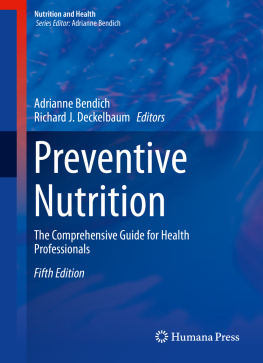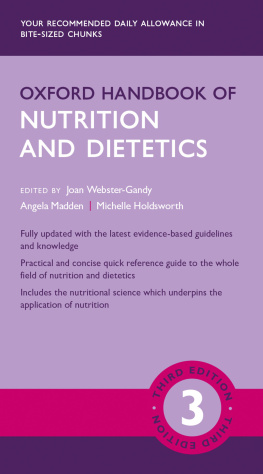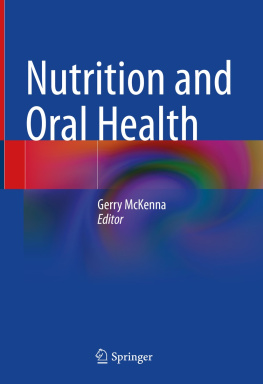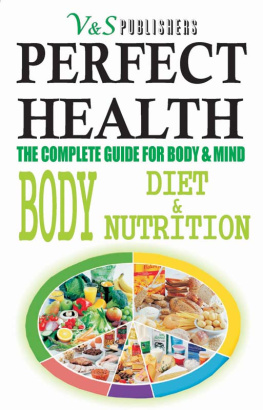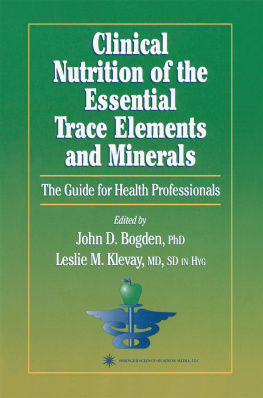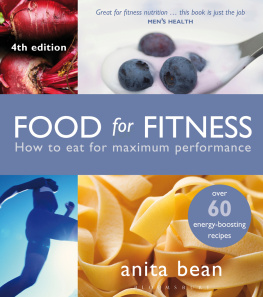Adrianne Bendich - Nutrition and Health: Preventive Nutrition
Here you can read online Adrianne Bendich - Nutrition and Health: Preventive Nutrition full text of the book (entire story) in english for free. Download pdf and epub, get meaning, cover and reviews about this ebook. City: Cham, year: 2016, publisher: Springer International Publishing, genre: Science. Description of the work, (preface) as well as reviews are available. Best literature library LitArk.com created for fans of good reading and offers a wide selection of genres:
Romance novel
Science fiction
Adventure
Detective
Science
History
Home and family
Prose
Art
Politics
Computer
Non-fiction
Religion
Business
Children
Humor
Choose a favorite category and find really read worthwhile books. Enjoy immersion in the world of imagination, feel the emotions of the characters or learn something new for yourself, make an fascinating discovery.
- Book:Nutrition and Health: Preventive Nutrition
- Author:
- Publisher:Springer International Publishing
- Genre:
- Year:2016
- City:Cham
- Rating:4 / 5
- Favourites:Add to favourites
- Your mark:
- 80
- 1
- 2
- 3
- 4
- 5
Nutrition and Health: Preventive Nutrition: summary, description and annotation
We offer to read an annotation, description, summary or preface (depends on what the author of the book "Nutrition and Health: Preventive Nutrition" wrote himself). If you haven't found the necessary information about the book — write in the comments, we will try to find it.
Nutrition and Health: Preventive Nutrition — read online for free the complete book (whole text) full work
Below is the text of the book, divided by pages. System saving the place of the last page read, allows you to conveniently read the book "Nutrition and Health: Preventive Nutrition" online for free, without having to search again every time where you left off. Put a bookmark, and you can go to the page where you finished reading at any time.
Font size:
Interval:
Bookmark:
Global Issues
- National dietary guidelines for general audiences are increasingly focused on a holistic view of nutrition with an emphasis on whole foods and dietary patterns in the context of long-term environmental sustainability.
- Personally tailored nutrition guidance is emerging via assessment of genetic and biochemical profiles directed to individualized dietary recommendations for health promotion and disease prevention.
- The Socioecological Model, Health Belief Model, Theory of Reasoned Action and Planned Behavior, Transtheoretical Model, and Social Cognitive Theory are frameworks that help to explain and predict dietary behavior at the individual level.
- Motivational interviewing is an effective behavioral strategy at the individual level within a health care setting for promoting dietary behavior change.
- Smartphone applications may be useful tools to promote dietary behavior change and assist with self-monitoring of dietary behaviors.
- Culture strongly influences dietary preferences and health beliefs also influence dietary behaviors.
- Health care professionals can play broad but nontraditional roles in support of their patients by addressing the upstream root causes of diseases and conditions related to diet.
- Policies at global, national, and local levels can shape dietary behaviors by influencing food availability and price, dietary guidelines, nutrition information, nutrition standards, and support for nutrition programs.
Font size:
Interval:
Bookmark:
Similar books «Nutrition and Health: Preventive Nutrition»
Look at similar books to Nutrition and Health: Preventive Nutrition. We have selected literature similar in name and meaning in the hope of providing readers with more options to find new, interesting, not yet read works.
Discussion, reviews of the book Nutrition and Health: Preventive Nutrition and just readers' own opinions. Leave your comments, write what you think about the work, its meaning or the main characters. Specify what exactly you liked and what you didn't like, and why you think so.

